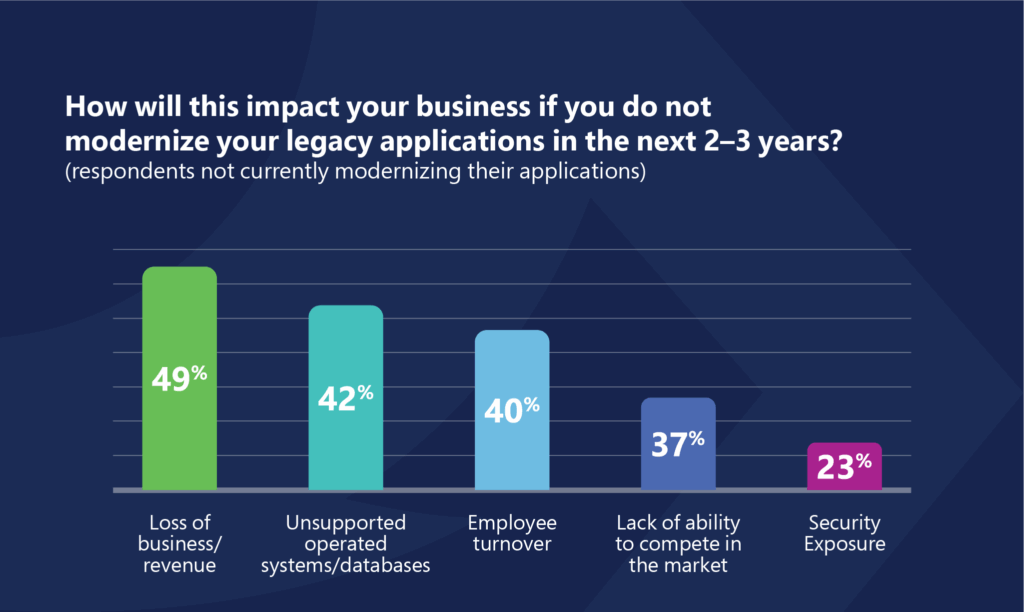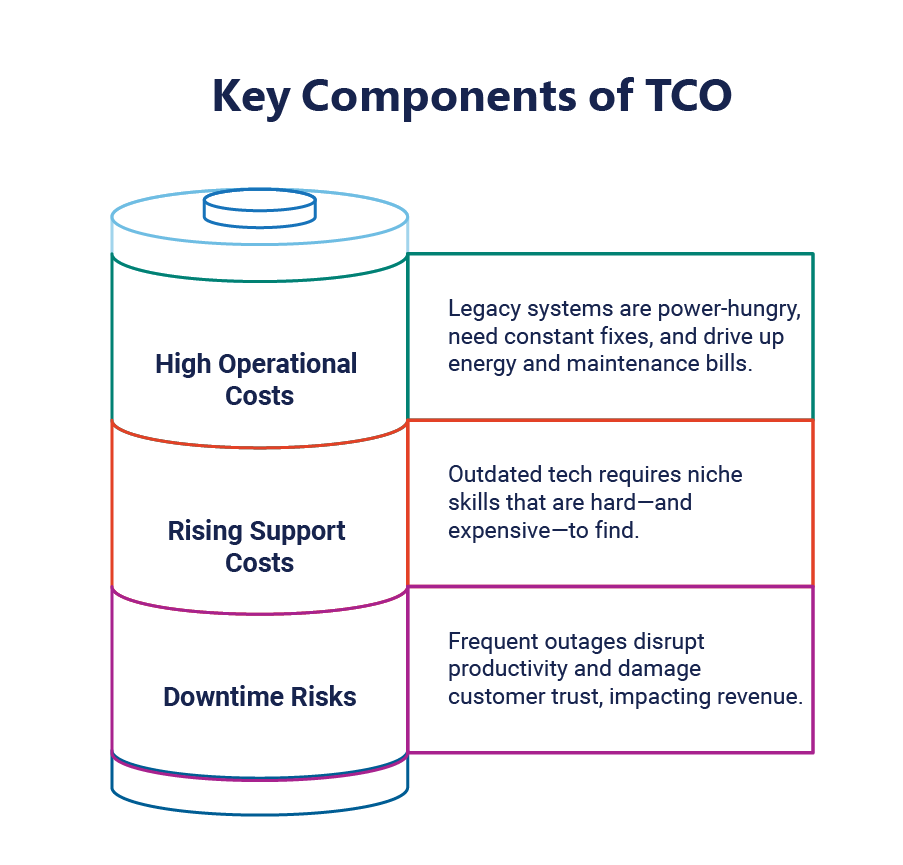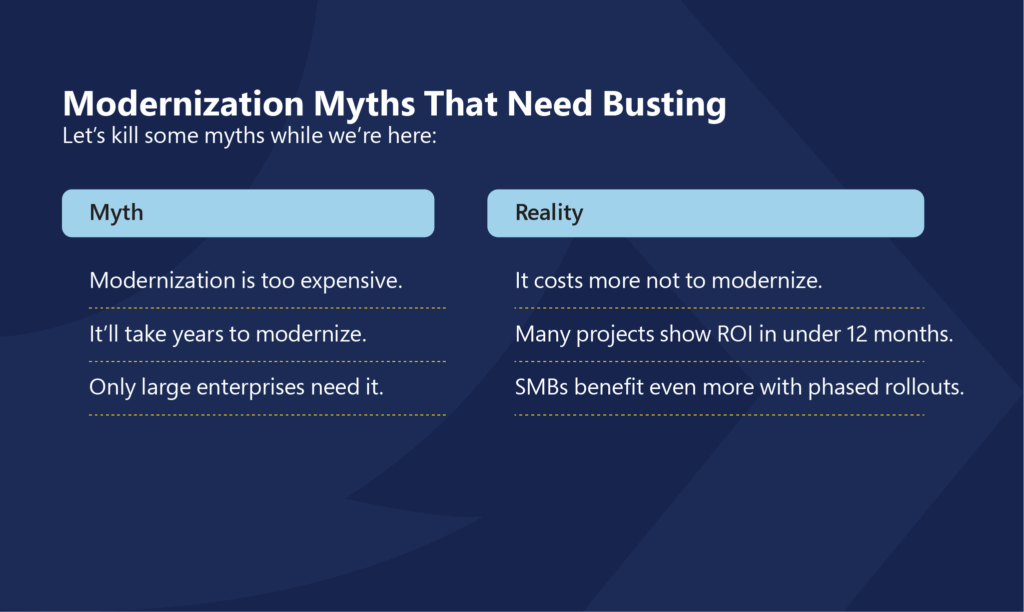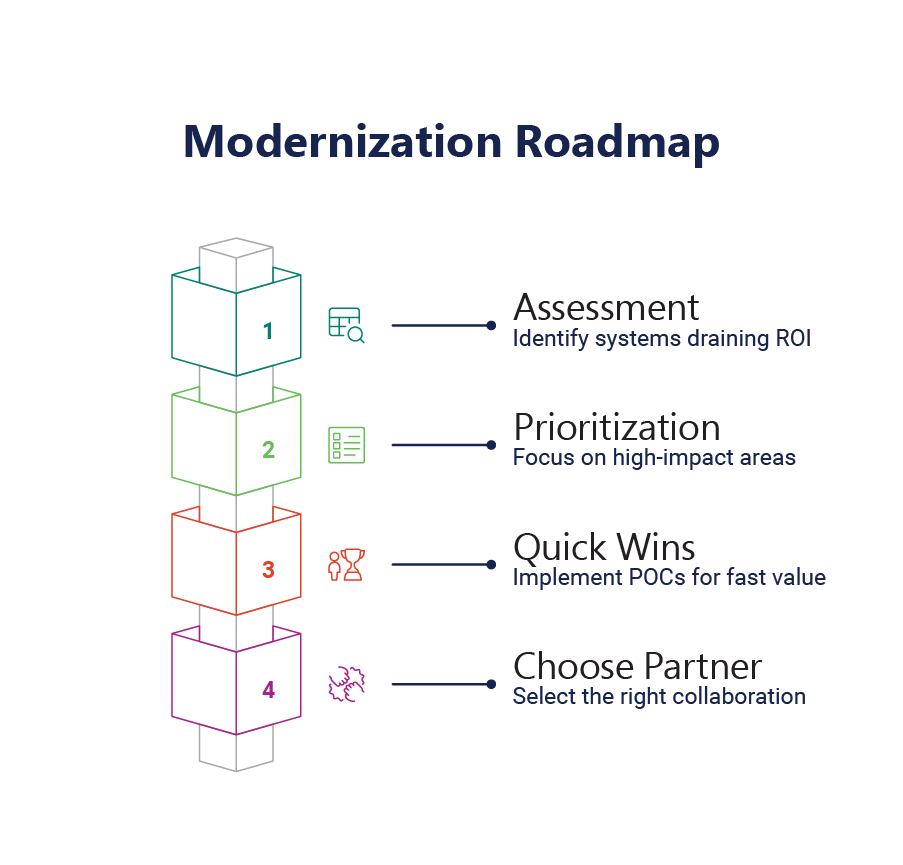“Why fix what isn’t broken?” It’s the go-to argument when business leaders are asked about replacing legacy systems. On the surface, legacy applications seem reliable—stable workhorses that have served for decades. But beneath that surface lies a costly illusion. What feels familiar may be silently siphoning away your ROI, agility, and competitive edge.
Here’s a stat that stops you in your tracks: According to McKinsey, technical debt will cost organizations $5 trillion in lost productivity by 2030 if left unchecked. Add to that the $4.45 million average cost of a data breach (IBM), and the narrative shifts quickly: It’s not about whether you can afford legacy modernization—it’s about whether you can afford not to.
But the real FOMO is “Companies that modernize their core applications see up to 40% faster time-to-market, 30% reduction in operational costs, and double-digit revenue growth in less than two years.”(McKinsey)
So, the real question then becomes: Can you afford the hidden costs of legacy systems? Let’s break down the true costs of inaction—and why modernizing your applications is no longer optional, but essential.
The ROI-Driven Business Case for Application Modernization
Modernizing legacy applications can lead to significant returns on investment (ROI) by enhancing operational efficiency, reducing costs, and enabling organizations to respond swiftly to market changes.
Direct ROI Gains from Modern Platforms
Modern platforms are designed for speed, scalability, and innovation. They reduce development time, simplify deployments, and support agile delivery. With cloud-native capabilities, teams can roll out new features faster and respond to market demands in real time. This isn’t just efficiency—its money saved and revenue earned through faster time-to-market and better product velocity.
For instance, organizations utilizing Azure PaaS experienced a 228% ROI over three years, with a 50% increase in application development speed and a 40% reduction in app development-related infrastructure costs. (Microsoft Azure)
Operational Efficiency & Cost Control
Legacy systems are expensive to maintain and difficult to manage. Every fix is slow, risky, and resource intensive. Modern applications streamline operations with automation, self-healing infrastructure, and on-demand scalability. You reduce downtime, cut manual effort, and only pay for what you use—leading to leaner operations and lower costs across the board.
By transitioning to cloud-based solutions, organizations can lower infrastructure costs and reduce energy consumption by 30-60%, enhancing operational efficiency.
Don’t Miss This Read: Legacy Modernization: A Necessity for Digital Evolution
Customer Experience & Market Responsiveness
Your customers expect fast, reliable, and intuitive digital experiences. Legacy systems often can’t deliver. Modern applications empower businesses to offer seamless, personalized, and omni-channel services that keep users engaged. Just as importantly, they allow you to adapt quickly to market shifts—keeping your brand relevant and responsive.
The True Cost of Inaction: What Happens When You Do Nothing
When businesses delay application modernization, they often focus on the immediate savings—avoiding short-term disruption, reducing capital expenditure, or maintaining “what’s already working.” But beneath the surface lies a complex web of operational bottlenecks, technical liabilities, and escalating risks that silently erode profitability.
According to a recent industry study, organizations that delay modernization are already feeling the heat. From lost revenue to rising employee turnover, here’s how businesses expect to suffer if they don’t act within the next 2–3 years:

1. Operational Inefficiencies: Slower, Costlier, and Riskier
Legacy systems were built for a different era—one where daily batch processing, monolithic codebases, and manual workarounds were standard. Today, they’ve become bottlenecks. These systems lack the agility and automation required to compete in a fast-paced, digitally connected world. Integrating them with newer tools or cloud-native apps is often difficult and costly, leading to inconsistent data, duplicated efforts, and sluggish go-to-market timelines.
According to IDC, organizations lose 20–30% of their annual revenue due to inefficiencies stemming from outdated IT systems.
2. Increased Technical Debt: Paying the Interest of Procrastination
Technical debt isn’t just a developer issue—it’s a business issue. Every time a feature is delayed due to system limitations or every patch applied without refactoring the core, your company incurs more technical debt. Over time, this debt snowballs, making your applications harder to maintain, less secure, and more expensive to upgrade.
Many enterprises fall into the trap of “band-aid” solutions—keeping legacy systems on life support rather than investing in scalable transformation. But, according to Gartner, 60–80% of IT budgets are spent just maintaining these aging systems, leaving little room for innovation or strategic projects.

3. Security Vulnerabilities: Outdated and Unprotected
Older applications weren’t built for today’s cybersecurity landscape. They often lack basic encryption standards, multi-factor authentication, API security, or real-time threat detection. Worse, many legacy systems are no longer supported by vendors, meaning critical patches may no longer be available—leaving known vulnerabilities unaddressed.
IBM’s 2023 report shows the average cost of a data breach has risen to $4.45 million, a 15% increase over just three years.
4. Limited Scalability: When Growth Breaks the System
Modern businesses need systems that scale on demand—whether that’s during a viral product launch, seasonal traffic spikes, or expanding into new regions. Legacy systems, with their tightly coupled architectures and hardware dependencies, simply can’t stretch that far.
What Happens When You Don’t Scale: One e-commerce company learned this the hard way. During Black Friday, its traffic surged, but the underlying monolithic system crashed repeatedly. Orders were lost, customers turned to competitors, and revenue dipped. The following year, they migrated to a cloud-native microservices architecture and achieved 99.99% uptime during peak periods. Result? A 35% increase in holiday sales and a major boost in brand loyalty.
| Action | Impact on MTTR | Impact on MTBF | Impact on Availability |
|---|---|---|---|
| Reduce MTTR | Decreases | Increases slightly | Increases significantly |
| Increase MTBF | Increases | Increases significantly | Increases moderately |
| Action | Impact on MTTR | Impact on MTBF | Impact on Availability |
|---|---|---|---|
| Reduce MTTR | Decreases | Increases slightly | Increases significantly |
| Increase MTBF | Increases | Increases significantly | Increases moderately |
5. Talent Drain: Outdated Tech Drives Away Talent
How Quinnox’s Qinfinite Knowledge Graph Revolutionizes IT Asset Management
Skilled tech talent wants to build, innovate, and solve real-world problems—not babysit code written in the ’90s. Developers are increasingly rejecting roles that require them to work with outdated languages like COBOL, Visual Basic, or on-prem mainframes. This not only creates hiring challenges but increases dependency on a shrinking pool of legacy specialists—many of whom are retiring or command exorbitant rates.
Financial Impact: A Strategic Look at ROI vs. TCO
In the race toward digital excellence, understanding the true financial cost of clinging to outdated systems is critical. While legacy systems may still “work,” they quietly drain resources, hinder innovation, and amplify business risk.
The Hidden Cost of Legacy: TCO Isn’t Just About Maintenance
When companies calculate the Total Cost of Ownership (TCO) for legacy systems, they often stop at visible costs like hardware upgrades or support contracts. But that’s just the tip of the iceberg. TCO includes everything from unplanned downtime and security vulnerabilities to lost agility and innovation bottlenecks.
According to research, maintaining legacy systems can cost companies an average of $30 million annually, contributing to a global spending of over $1.14 trillion on outdated IT infrastructure.

ROI Benchmarks from Modernization Projects
Modernization projects often yield significant returns. For example, organizations that transitioned to modern platforms reported:
- Improved Performance: Enhanced system reliability and uptime.
- Cost Savings: Reduction in infrastructure and maintenance expenses.
These improvements contribute to a favorable ROI, justifying the initial investment in modernization.

Opportunity Cost of Delay in Modernization
Delaying modernization efforts can result in substantial opportunity costs. According to industry research, postponing digital transformation can lead to lost efficiencies and revenues, as well as customer attrition.
Potential losses include:
- Market Share: Falling behind competitors who adopt new technologies.
- Revenue: Missing out on new business opportunities due to system limitations.
Next Steps: Crafting Your Modernization Roadmap
Modernizing your IT landscape or digital systems is essential—but jumping into it without a clear, structured plan can lead to costly missteps. A roadmap gives you the direction and clarity to modernize efficiently and strategically. Here’s how to break it down:

1. Assessment: Identify Systems Draining the Most ROI
Evaluating your existing systems and identifying which ones are draining your ROI is essential. These might be legacy platforms that are expensive to maintain, slow down operations, hinder customer experience, or make innovation difficult. For example, if your order management system frequently causes delays or lacks real-time tracking capabilities, it could hurt both your operational costs and customer satisfaction.
2. Prioritization: Modernize High-Impact Areas First
Once the underperforming systems are identified, the next move is prioritization. Not every system needs to be modernized immediately. The key is to focus on areas that will deliver the most business value—whether through improved agility, enhanced customer experience, or cost savings. Prioritization criteria might include alignment with business goals, the potential cost-benefit ratio, regulatory needs, or urgency from stakeholders.
3. Quick Wins: Choose POCs That Deliver Fast Value
With priorities set, organizations should then look for quick wins through Proof of Concept (POC) initiatives. These small-scale efforts can demonstrate tangible results in a short time and build internal momentum. Quick wins might involve migrating a single legacy application to the cloud, automating a time-consuming manual testing process, or replacing a sluggish monolithic service with a nimble microservice.
4. Choose the Right Partner
Finally, one of the most crucial steps in the modernization journey is choosing the right partner. Modernization is a complex endeavor, often involving multiple disciplines such as cloud adoption, automation, security, and systems integration. Partnering with an experienced platform like Qinfinite can make all the difference. Qinfinite provides AI-powered insights to drive smarter decision-making, ensures secure and scalable transformations, and comes with pre-built accelerators and industry best practices.
Summing Up
The decision to modernize applications is not merely a technical one; it’s a strategic imperative that affects every facet of your organization. From operational efficiency and cost savings to customer satisfaction and competitive advantage, the benefits are substantial and well-documented.
Neglecting modernization can lead to escalating costs, security vulnerabilities, and lost opportunities. Conversely, embracing modern architecture positions your organization for sustained growth and success in an increasingly digital world.
So, are you ready to modernize without losing your mind (or budget)? Then Quinnox’s intellignet application management platform, Qinfinite is your right partner that can help you leap from legacy to leading edge—securely, scalably, and smartly. Want fewer bugs, better user experiences, and happier developers? You know what to do. Schedule a FREE Consultation with our experts today!
FAQs on Application Modernization and ROI
Application modernization enables businesses to keep up with evolving customer expectations, integrate emerging technologies, enhance security, and respond faster to market shifts. Without modernization, businesses risk being outpaced by more agile competitors who can innovate and scale rapidly.
Timelines vary based on the size and complexity of the systems involved. However, organizations typically begin to see measurable results within 6 to 12 months when focusing on targeted modernization efforts like rehosting, containerization, or automating key workflows.
Legacy systems often appear “cheaper” because they’re already in place—but beneath the surface, they carry significant hidden costs. These include high maintenance fees, security vulnerabilities, increased downtime, integration challenges, and difficulty in sourcing skilled support.
Absolutely not. In fact, mid-sized businesses are often more agile and can realize the benefits of modernization faster by adopting a phased approach.
Legacy systems can severely drag down ROI by consuming a disproportionate share of IT budgets while delivering diminishing returns. They often result in slower operations, longer development cycles, increased risk of system failures, and poor customer experience.
Key metrics include reduced downtime, faster time-to-market, improved NPS scores, lowered TCO, and increased conversion or retention rates.
Not at all. In fact, a phased or hybrid approach is often more strategic and cost-effective. Start with systems that offer the greatest business impact or ROI, such as customer-facing applications or those with high maintenance costs.
How Qinfinite’s Knowledge Graph Can Be a Game Changer
At Qinfinite, we recognize the challenges faced by enterprises in managing complex IT environments. With our Intelligent Application Management (iAM) platform powered by an advanced knowledge graph, we help organizations with a living map of their entire IT universe to streamline their application management processes, boost efficiency, and drive cost savings.
Qinfinite’s knowledge graph enables organizations to:
- Gain a Unified View of IT Operations: By integrating data across various applications and IT systems, Qinfinite’s knowledge graph provides a holistic view of your IT landscape, making it easier to manage applications, detect issues, and optimize performance.
- Reduce Operational Costs and Increase Efficiency: Qinfinite’s AI-driven insights, derived from the knowledge graph, enable organizations to automate routine tasks, identify inefficiencies, and improve operational workflows. This can lead to cost reductions of up to 60% and a 70% increase in operational efficiency.
- Accelerate Root Cause Analysis (RCA): With its ability to map complex relationships between applications and systems, Qinfinite’s knowledge graph accelerates RCA, reducing time to diagnosis by up to 80% and enabling faster resolution of issues.
- Enhance Decision-Making: The intelligent insights from the knowledge graph help decision-makers quickly identify opportunities for innovation, enhance service delivery, and optimize resource allocation, enabling businesses to stay ahead of the competition.
In summary, knowledge graphs are an invaluable tool for enterprise application management. By transforming how data is connected, analyzed, and acted upon, they enable businesses to operate more efficiently, reduce costs, and make better decisions. With Qinfinite’s powerful knowledge graph technology, enterprises can unlock the full potential of their IT ecosystems and stay agile in today’s rapidly evolving market.